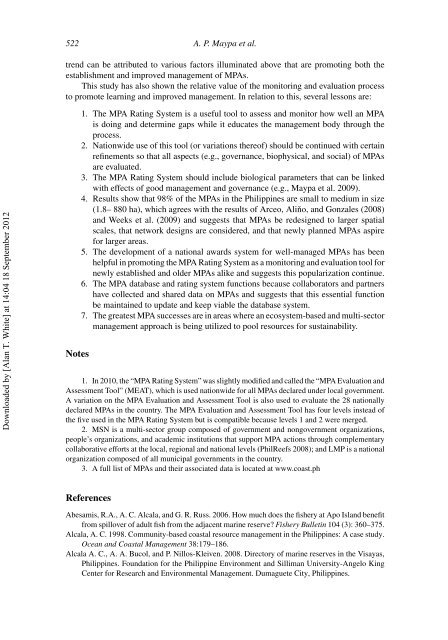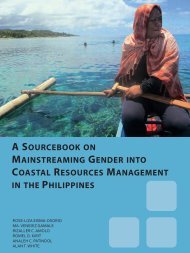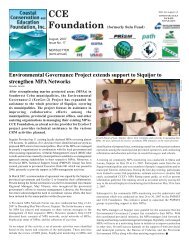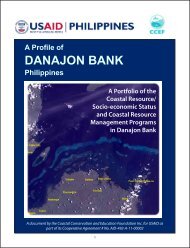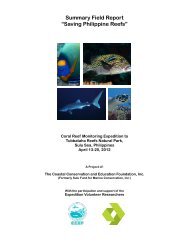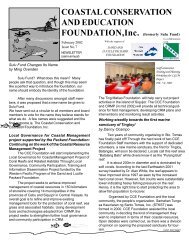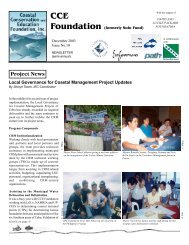Marine Protected Area Management Effectiveness: Progress and ...
Marine Protected Area Management Effectiveness: Progress and ...
Marine Protected Area Management Effectiveness: Progress and ...
Create successful ePaper yourself
Turn your PDF publications into a flip-book with our unique Google optimized e-Paper software.
Downloaded by [Alan T. White] at 14:04 18 September 2012<br />
522 A. P. Maypa et al.<br />
trend can be attributed to various factors illuminated above that are promoting both the<br />
establishment <strong>and</strong> improved management of MPAs.<br />
This study has also shown the relative value of the monitoring <strong>and</strong> evaluation process<br />
to promote learning <strong>and</strong> improved management. In relation to this, several lessons are:<br />
Notes<br />
1. The MPA Rating System is a useful tool to assess <strong>and</strong> monitor how well an MPA<br />
is doing <strong>and</strong> determine gaps while it educates the management body through the<br />
process.<br />
2. Nationwide use of this tool (or variations thereof) should be continued with certain<br />
refinements so that all aspects (e.g., governance, biophysical, <strong>and</strong> social) of MPAs<br />
are evaluated.<br />
3. The MPA Rating System should include biological parameters that can be linked<br />
with effects of good management <strong>and</strong> governance (e.g., Maypa et al. 2009).<br />
4. Results show that 98% of the MPAs in the Philippines are small to medium in size<br />
(1.8– 880 ha), which agrees with the results of Arceo, Aliňo, <strong>and</strong> Gonzales (2008)<br />
<strong>and</strong> Weeks et al. (2009) <strong>and</strong> suggests that MPAs be redesigned to larger spatial<br />
scales, that network designs are considered, <strong>and</strong> that newly planned MPAs aspire<br />
for larger areas.<br />
5. The development of a national awards system for well-managed MPAs has been<br />
helpful in promoting the MPA Rating System as a monitoring <strong>and</strong> evaluation tool for<br />
newly established <strong>and</strong> older MPAs alike <strong>and</strong> suggests this popularization continue.<br />
6. The MPA database <strong>and</strong> rating system functions because collaborators <strong>and</strong> partners<br />
have collected <strong>and</strong> shared data on MPAs <strong>and</strong> suggests that this essential function<br />
be maintained to update <strong>and</strong> keep viable the database system.<br />
7. The greatest MPA successes are in areas where an ecosystem-based <strong>and</strong> multi-sector<br />
management approach is being utilized to pool resources for sustainability.<br />
1. In 2010, the “MPA Rating System” was slightly modified <strong>and</strong> called the “MPA Evaluation <strong>and</strong><br />
Assessment Tool” (MEAT), which is used nationwide for all MPAs declared under local government.<br />
A variation on the MPA Evaluation <strong>and</strong> Assessment Tool is also used to evaluate the 28 nationally<br />
declared MPAs in the country. The MPA Evaluation <strong>and</strong> Assessment Tool has four levels instead of<br />
the five used in the MPA Rating System but is compatible because levels 1 <strong>and</strong> 2 were merged.<br />
2. MSN is a multi-sector group composed of government <strong>and</strong> nongovernment organizations,<br />
people’s organizations, <strong>and</strong> academic institutions that support MPA actions through complementary<br />
collaborative efforts at the local, regional <strong>and</strong> national levels (PhilReefs 2008); <strong>and</strong> LMP is a national<br />
organization composed of all municipal governments in the country.<br />
3. A full list of MPAs <strong>and</strong> their associated data is located at www.coast.ph<br />
References<br />
Abesamis, R.A., A. C. Alcala, <strong>and</strong> G. R. Russ. 2006. How much does the fishery at Apo Isl<strong>and</strong> benefit<br />
from spillover of adult fish from the adjacent marine reserve? Fishery Bulletin 104 (3): 360–375.<br />
Alcala, A. C. 1998. Community-based coastal resource management in the Philippines: A case study.<br />
Ocean <strong>and</strong> Coastal <strong>Management</strong> 38:179–186.<br />
Alcala A. C., A. A. Bucol, <strong>and</strong> P. Nillos-Kleiven. 2008. Directory of marine reserves in the Visayas,<br />
Philippines. Foundation for the Philippine Environment <strong>and</strong> Silliman University-Angelo King<br />
Center for Research <strong>and</strong> Environmental <strong>Management</strong>. Dumaguete City, Philippines.


